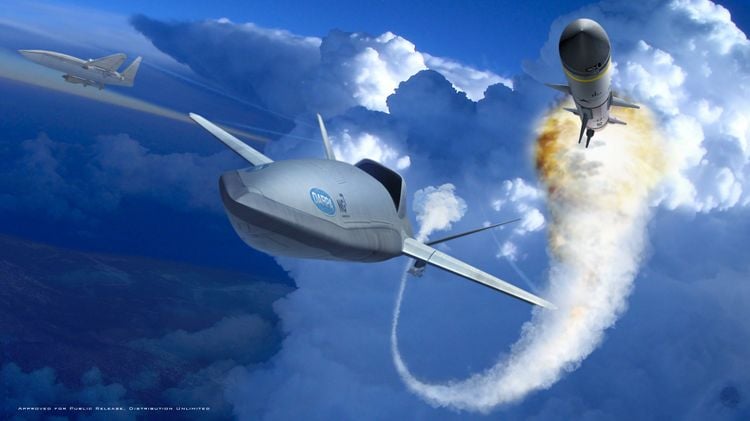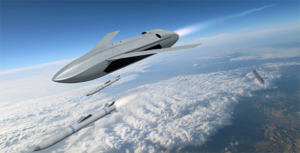
DARPA’s LongShot drone, Northrop Grumman concept art
WASHINGTON: DARPA plans to flight test a prototype of a novel air-launched drone — one designed to launch its own high-speed air-to-air missiles — as soon as the first half of 2024.
LongShot is conceived as an autonomous, air-launched uninhabited aerial vehicle (UAV) that can serve as a sort of mothership, launching its own air-to-air missiles once in range of enemy aircraft.
DARPA has tapped General Atomics, Lockheed Martin and Northrop Grumman to provide preliminary designs under Phase 1 of its new LongShot program. LongShot aims to demonstrate a drone that would be launched by fighters or bombers flying at stand-off ranges, autonomously fly into enemy airspace, and then launch its own air-to-air missiles to take down enemy aircraft.
Phase 1 of the program will last 12 months, and culminate in a preliminary design review, a DARPA spokesperson said in an email today. Following that review, Phase II “is planned to be a 9-month effort culminating in a critical design review and should include some risk reduction testing. Phase III is planned to be a 21-month effort to manufacture and flight test a LongShot demonstration system.”
Only one of the three, however, will be chosen for Phase III. “One performer is planned to go into flight test based on the currently allocated budget,” the spokesperson said.
DARPA budgeted $22 million for LongShot in 2021, according to budget justification documents, but did not provide out-year requests or an overall program cost. Further, the spokesperson declined to provide contract values for Phase 1, saying public release of the costs has yet to be approved.
“The objective is to develop a novel UAV that can significantly extend engagement ranges, increase mission effectiveness, and reduce the risk to manned aircraft,” according to the DARPA website. “It is envisioned that LongShot will increase the survivability of manned platforms by allowing them to be at standoff ranges far away from enemy threats, while an air-launched LongShot UAV efficiently closes the gap to take more effective missile shots.”
Key to the effort is the utilization of “multi-modal propulsion,” the spokesperson explained, which “can be interpreted as using a slower speed, high-efficiency turbine engine for ingress, while using a highly-energetic rocket powered air-to-air missiles for end-game target engagements.”
Northrop Grumman is “using multi-disciplinary design analysis and optimization, computational fluid dynamics to create digital models of the system during the design process,” Jaime Engdahl, Northrop Grumman’s program director, kinetic weapons and emerging capabilities, said in an email. “We have a parallel digital twin effort ongoing with the Air Force Research Laboratory with our Gray Wolf weapon system and we definitely plan on leveraging that pioneering work on the LongShot program.”
A spokesperson for Lockheed Martin declined to comment; likewise a spokesperson from General Atomics referred all questions back to DARPA.

LongShot drone, DARPA image
The ‘mothership’ drone could be sized to fit either bombers or fighters, or perhaps both, the DARPA spokesperson said. “The selected performers will conduct trade studies to determine the best viable employment aircraft for the LongShot vehicle,” the spokesperson explained.
“For each fighter and bomber aircraft there are unique weight and size limitations that internal and external stores must meet in order to be carried on that aircraft,” Engdahl said. “DARPA has asked our company to meet those requirements. The Northrop Grumman autonomous system is sized so that it may be carried on existing fighters and bombers.”
Air Force Global Strike Command has wanted for some time to explore concepts to improve the stand-off range of its bomber fleet in the face of increased air-defense capabilities of peer adversaries Russia and China, including the idea of a cheap “bomb-truck.”
As for fighters, the Air Force has been exploring the concept of teaming piloted aircraft with autonomous drones as ‘wingmen’ — for example, under the Skyborg program. Former Air Force acquisition head Will Roper put into play the Digital Century Series concept to develop a Next-Generation Air Dominance (NGAD) fighter that includes the idea of teaming multiple uninhabited aerial vehicles (UAVs) with a piloted sixth-generation jet.
DARPA is targeting both the Air Force and Navy as potential transition partners, the spokesperson said.
China’s new H-20 stealth bomber ‘not really’ a concern for Pentagon, says intel official
“The thing with the H-20 is when you actually look at the system design, it’s probably nowhere near as good as US LO [low observable] platforms, particularly more advanced ones that we have coming down,” said a DoD intelligence official.


























